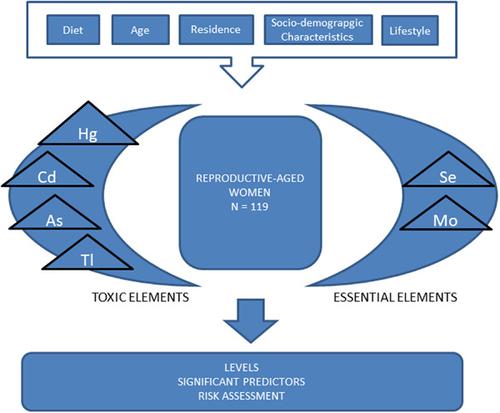当前位置:
X-MOL 学术
›
Environ. Toxicol. Chem.
›
论文详情
Our official English website, www.x-mol.net, welcomes your feedback! (Note: you will need to create a separate account there.)
Exposure and Risk Assessment of Hg, Cd, As, Tl, Se, and Mo in Women of Reproductive Age Using Urinary Biomonitoring
Environmental Toxicology and Chemistry ( IF 4.1 ) Pub Date : 2021-01-25 , DOI: 10.1002/etc.4996 Clara Coscollà 1 , Alfredo Sánchez 2 , Francisca Corpas-Burgos 1 , Antonio López 1 , Rosa Pérez 1 , Julia Kuligowski 3 , Máximo Vento 4 , Vicent Yusà 1, 5, 6
Environmental Toxicology and Chemistry ( IF 4.1 ) Pub Date : 2021-01-25 , DOI: 10.1002/etc.4996 Clara Coscollà 1 , Alfredo Sánchez 2 , Francisca Corpas-Burgos 1 , Antonio López 1 , Rosa Pérez 1 , Julia Kuligowski 3 , Máximo Vento 4 , Vicent Yusà 1, 5, 6
Affiliation

|
The present study analyzed the exposure and risk assessment of 4 toxic (Hg, Cd, As, Tl) and 2 essential (Se, Mo) elements in 119 Spanish women of reproductive age. The focus was on the elements for which risk‐based benchmark, biomonitoring equivalents, or health‐related human biomonitoring values have already been established. All elements presented frequencies of detection of 100% (greater than the limit of detection), except for Cd (99%). The 95th percentile concentrations were, for the toxic metals, 358.37 µg/L (total As), 1.10 µg/L (Cd), 0.41 µg/L (Tl), and 3.03 µg/L (total Hg) and, for the essential elements, 68.95 µg/L (total Se) and 154.67 (Mo). We examined sociodemographic factors and dietary habits of women as predictors of urinary metal concentrations. Arsenic was positively associated with fish, shellfish, and canned fish consumption, whereas Mo was found to be associated with the consumption of cereals and pastry products. Maternal urine levels of As were negatively correlated with gestational age. In a risk‐assessment context, hazard quotients (HQs) using the 95th percentile ranged from 0.08 (Tl) to 15.1 (urinary speciated As), with Cd presenting an HQ of 1.1 (95th percentile). None of the essential metals presented concentrations higher than their upper intake level; however, 3% of the mothers showed lower levels of Se than the estimated average requirement (EAR) biomonitoring equivalent, and 20% of the mothers were found to have lower levels of Mo than the EAR biomonitoring equivalent, suggesting a nutritionally inadequate diet. Environ Toxicol Chem 2021;40:1477–1490. © 2021 SETAC
中文翻译:

使用尿液生物监测对育龄妇女的 Hg、Cd、As、Tl、Se 和 Mo 进行暴露和风险评估
本研究分析了 119 名西班牙育龄妇女对 4 种有毒元素(Hg、Cd、As、Tl)和 2 种必需元素(Se、Mo)的暴露和风险评估。重点是已经建立了基于风险的基准、生物监测等效物或与健康相关的人类生物监测值的要素。除 Cd (99%) 外,所有元素的检测频率均为 100%(大于检测限)。有毒金属的第 95 个百分位浓度为 358.37 µg/L(总砷)、1.10 µg/L(Cd)、0.41 µg/L(Tl)和 3.03 µg/L(总 Hg),对于基本元素,68.95 µg/L(总硒)和 154.67(钼)。我们检查了女性的社会人口学因素和饮食习惯作为尿液金属浓度的预测指标。砷与鱼类、贝类和罐头鱼类消费呈正相关,而 Mo 被发现与谷物和糕点产品的消费有关。母亲尿液中砷的水平与胎龄呈负相关。在风险评估环境中,使用第 95 个百分位的风险商数 (HQ) 的范围从 0.08 (Tl) 到 15.1(尿液特定 As),其中 Cd 的 HQ 为 1.1(第 95 个百分位数)。没有一种必需金属的浓度高于其摄入量上限;然而,3% 的母亲表现出低于估计平均需求 (EAR) 生物监测等效值的 Se 水平,并且发现 20% 的母亲的 Mo 水平低于 EAR 生物监测等效值,这表明饮食营养不足。母亲尿液中砷的水平与胎龄呈负相关。在风险评估环境中,使用第 95 个百分位的风险商数 (HQ) 的范围从 0.08 (Tl) 到 15.1(尿液特定 As),其中 Cd 的 HQ 为 1.1(第 95 个百分位数)。没有一种必需金属的浓度高于其摄入量上限;然而,3% 的母亲表现出低于估计平均需求 (EAR) 生物监测等效值的 Se 水平,并且发现 20% 的母亲的 Mo 水平低于 EAR 生物监测等效值,这表明饮食营养不足。母亲尿液中砷的水平与胎龄呈负相关。在风险评估环境中,使用第 95 个百分位的风险商数 (HQ) 的范围从 0.08 (Tl) 到 15.1(尿液特定 As),其中 Cd 的 HQ 为 1.1(第 95 个百分位数)。没有一种必需金属的浓度高于其摄入量上限;然而,3% 的母亲表现出低于估计平均需求 (EAR) 生物监测等效值的 Se 水平,并且发现 20% 的母亲的 Mo 水平低于 EAR 生物监测等效值,这表明饮食营养不足。没有一种必需金属的浓度高于其摄入量上限;然而,3% 的母亲表现出低于估计平均需求 (EAR) 生物监测等效值的 Se 水平,并且发现 20% 的母亲的 Mo 水平低于 EAR 生物监测等效值,这表明饮食营养不足。没有一种必需金属的浓度高于其摄入量上限;然而,3% 的母亲表现出低于估计平均需求 (EAR) 生物监测等效值的 Se 水平,并且发现 20% 的母亲的 Mo 水平低于 EAR 生物监测等效值,这表明饮食营养不足。环境毒理学化学2021;40:1477-1490。© 2021 SETAC
更新日期:2021-01-25
中文翻译:

使用尿液生物监测对育龄妇女的 Hg、Cd、As、Tl、Se 和 Mo 进行暴露和风险评估
本研究分析了 119 名西班牙育龄妇女对 4 种有毒元素(Hg、Cd、As、Tl)和 2 种必需元素(Se、Mo)的暴露和风险评估。重点是已经建立了基于风险的基准、生物监测等效物或与健康相关的人类生物监测值的要素。除 Cd (99%) 外,所有元素的检测频率均为 100%(大于检测限)。有毒金属的第 95 个百分位浓度为 358.37 µg/L(总砷)、1.10 µg/L(Cd)、0.41 µg/L(Tl)和 3.03 µg/L(总 Hg),对于基本元素,68.95 µg/L(总硒)和 154.67(钼)。我们检查了女性的社会人口学因素和饮食习惯作为尿液金属浓度的预测指标。砷与鱼类、贝类和罐头鱼类消费呈正相关,而 Mo 被发现与谷物和糕点产品的消费有关。母亲尿液中砷的水平与胎龄呈负相关。在风险评估环境中,使用第 95 个百分位的风险商数 (HQ) 的范围从 0.08 (Tl) 到 15.1(尿液特定 As),其中 Cd 的 HQ 为 1.1(第 95 个百分位数)。没有一种必需金属的浓度高于其摄入量上限;然而,3% 的母亲表现出低于估计平均需求 (EAR) 生物监测等效值的 Se 水平,并且发现 20% 的母亲的 Mo 水平低于 EAR 生物监测等效值,这表明饮食营养不足。母亲尿液中砷的水平与胎龄呈负相关。在风险评估环境中,使用第 95 个百分位的风险商数 (HQ) 的范围从 0.08 (Tl) 到 15.1(尿液特定 As),其中 Cd 的 HQ 为 1.1(第 95 个百分位数)。没有一种必需金属的浓度高于其摄入量上限;然而,3% 的母亲表现出低于估计平均需求 (EAR) 生物监测等效值的 Se 水平,并且发现 20% 的母亲的 Mo 水平低于 EAR 生物监测等效值,这表明饮食营养不足。母亲尿液中砷的水平与胎龄呈负相关。在风险评估环境中,使用第 95 个百分位的风险商数 (HQ) 的范围从 0.08 (Tl) 到 15.1(尿液特定 As),其中 Cd 的 HQ 为 1.1(第 95 个百分位数)。没有一种必需金属的浓度高于其摄入量上限;然而,3% 的母亲表现出低于估计平均需求 (EAR) 生物监测等效值的 Se 水平,并且发现 20% 的母亲的 Mo 水平低于 EAR 生物监测等效值,这表明饮食营养不足。没有一种必需金属的浓度高于其摄入量上限;然而,3% 的母亲表现出低于估计平均需求 (EAR) 生物监测等效值的 Se 水平,并且发现 20% 的母亲的 Mo 水平低于 EAR 生物监测等效值,这表明饮食营养不足。没有一种必需金属的浓度高于其摄入量上限;然而,3% 的母亲表现出低于估计平均需求 (EAR) 生物监测等效值的 Se 水平,并且发现 20% 的母亲的 Mo 水平低于 EAR 生物监测等效值,这表明饮食营养不足。环境毒理学化学2021;40:1477-1490。© 2021 SETAC



























 京公网安备 11010802027423号
京公网安备 11010802027423号